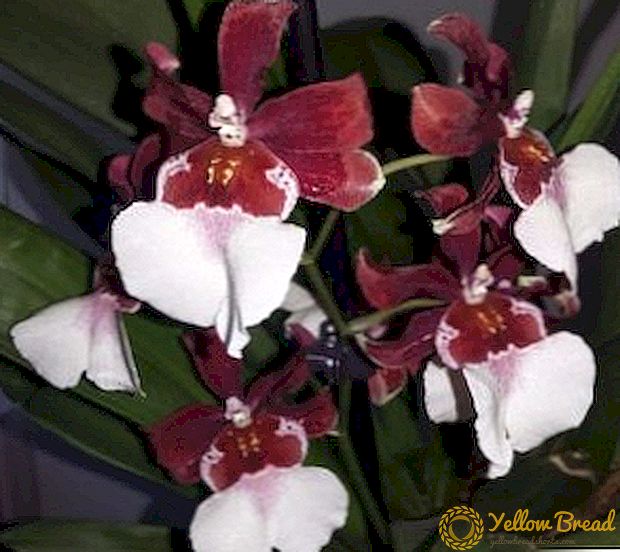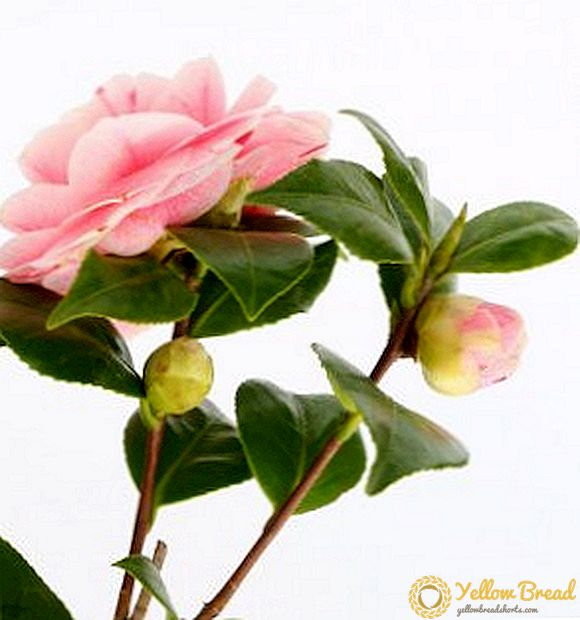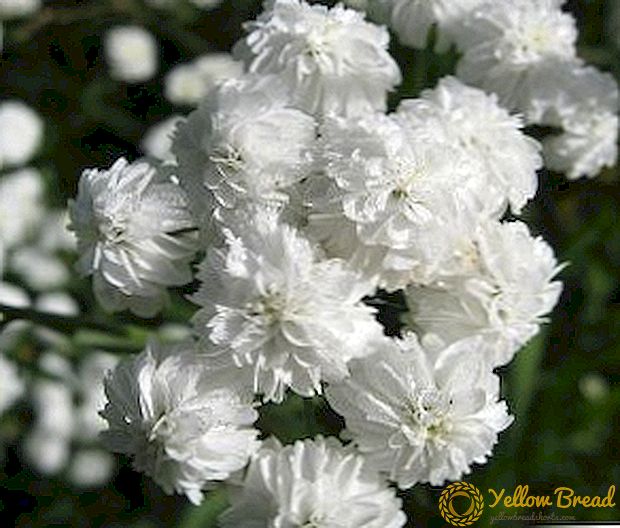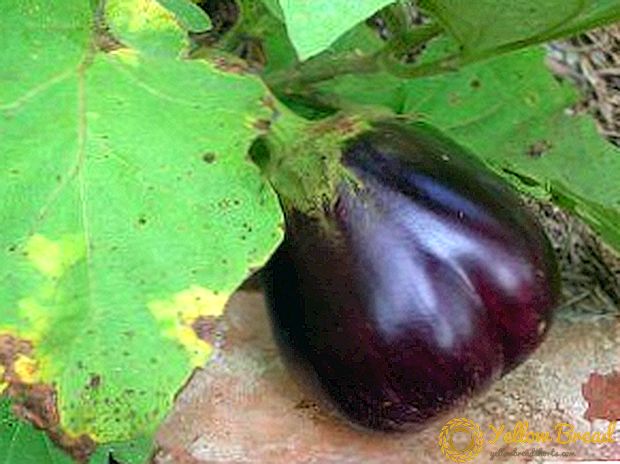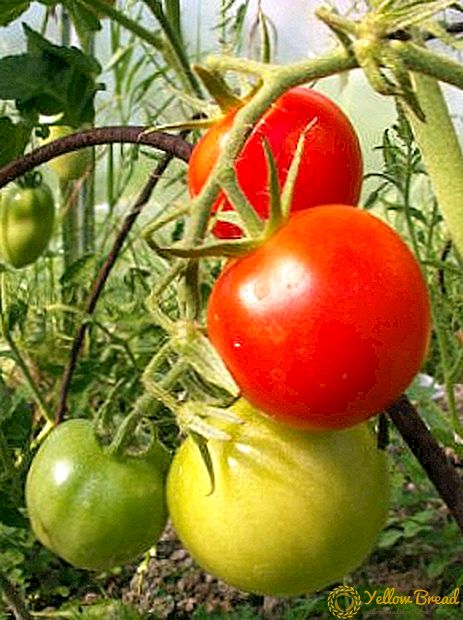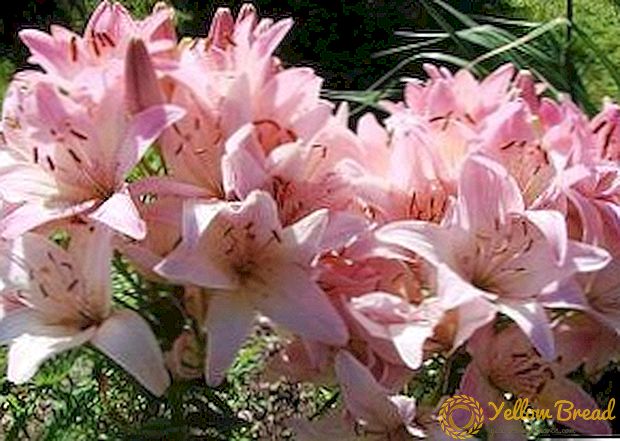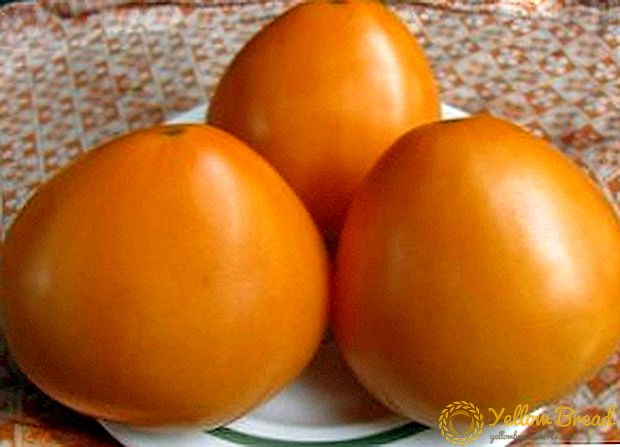 The variety of large-fruited tomatoes "Golden Domes" refers to the widely known tomato series "Siberian Garden". The second name of this series sounds like "Siberiada". Varietal tomatoes from this series are bred by purposeful and consistent selection by Siberian breeders. This series includes varieties that are resistant to temperature extremes and are well adapted to the climatic conditions of Siberia.
The variety of large-fruited tomatoes "Golden Domes" refers to the widely known tomato series "Siberian Garden". The second name of this series sounds like "Siberiada". Varietal tomatoes from this series are bred by purposeful and consistent selection by Siberian breeders. This series includes varieties that are resistant to temperature extremes and are well adapted to the climatic conditions of Siberia.
- Appearance and description of the variety
- Characteristics of the fruit
- The advantages and disadvantages of the variety
- Agrotechnology
- Seed preparation, planting seeds and care for them
- Seedlings and planting in the ground
- Care and watering
- Pests and diseases
- Conditions for maximum fruiting
- Use of fruits
Like the rest of the tomatoes in this series, the Golden Dome tomatoes are distinguished by high yields, resistance to weather extremes and to the main diseases of the nightshade.
Appearance and description of the variety
These tomatoes are deterministic varieties that can be grown with equal success in greenhouse and open ground conditions.
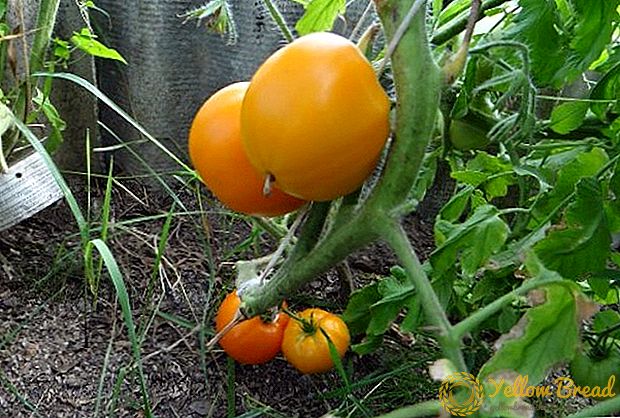 Description of the variety "Golden domes":
Description of the variety "Golden domes":
- tomatoes with yellow color of the fruit and yellow-orange flesh (see the photo below);
- large, fleshy, weight ranges from 400 to 800 g;
- the shape of the tomato is mild heart-shaped, flat-rounded;
- the variety is mid-season, the first fruits can be picked 3-3.5 months after the first shoots;
- bush height from 90 cm to 150 cm (when grown in a greenhouse, the height of the stems will be greater than in open ground);
- tomato bush is not a standard;
- bush's foliage is medium, leaves are drooping, weakly sprawling;
- possesses a complex brush in which from 5 to 14 fruits fit;
- variety mainly salad destination.
Characteristics of the fruit
Tomatoes "Golden domes" have excellent yield.In one brush of this variety can start 5 to 14 tomatoes. This form of brush is called a complex brush. The more tomatoes will be on one brush, the less weight each individual tomato will have.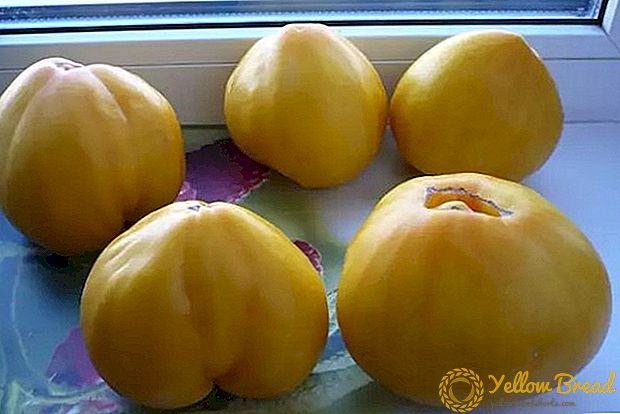 If only five or six tomatoes are tied onto a brush, then they usually reach very large sizes, each weighing more than half a kilo.
If only five or six tomatoes are tied onto a brush, then they usually reach very large sizes, each weighing more than half a kilo.
The advantages and disadvantages of the variety
Merits
But the main highlight of the tomatoes "Golden domes" is their taste. The flesh of these tomatoes is almost seedless, fleshy, with a small percentage of tomato juice.
The taste of these tomatoes is amazing, they have almost no acid, which in many people causes heartburn. We can say that this is the ideal variety of tomatoes for people with high acidity and are on a dietary basis.
disadvantages 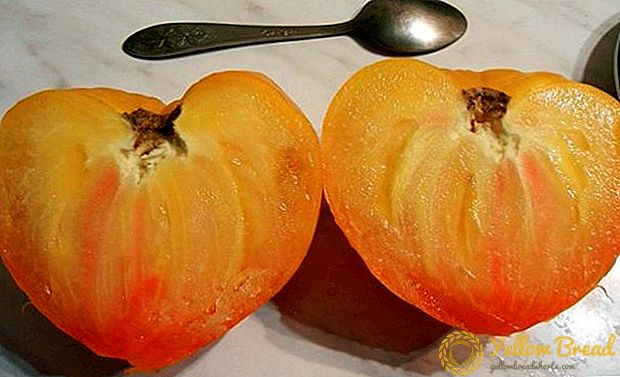 The peel of these tomatoes is strong, elastic, but not too thick. In the description of the variety, it is often forgotten to mention that with irregular but abundant irrigation on the tomato “Golden domes”, cracking may appear on the skin. This is due to the fact that when a large amount of water reaches the roots of the plant, the fruit quickly begins to gain additional weight.The skin of the tomato does not keep up with the rapid growth of cells, so the tomato can burst.
The peel of these tomatoes is strong, elastic, but not too thick. In the description of the variety, it is often forgotten to mention that with irregular but abundant irrigation on the tomato “Golden domes”, cracking may appear on the skin. This is due to the fact that when a large amount of water reaches the roots of the plant, the fruit quickly begins to gain additional weight.The skin of the tomato does not keep up with the rapid growth of cells, so the tomato can burst.
Agrotechnology
“Golden domes”, like all high-yield varieties of tomatoes in the “Siberiada” series, is unpretentious in maintenance, but it loves nutritious and fertilized soil. Also, plants need timely watering, loosening the soil, garter and protection from diseases and pests. 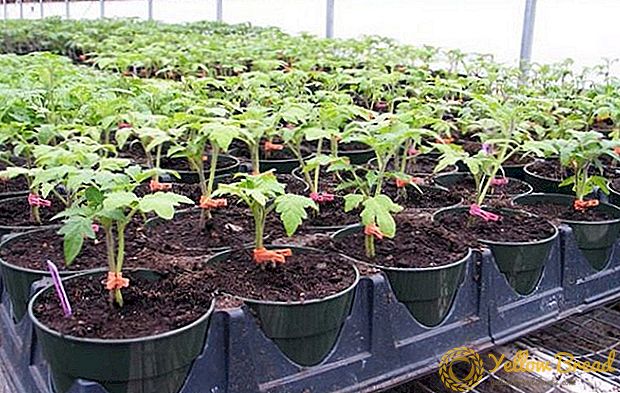
Seed preparation, planting seeds and care for them
Seeds of tomato "Golden domes" are sown on seedlings, in late February or early March. The time of sowing depends on the region in which the gardener lives, wishing to grow these tomatoes. For the cultivation of seedlings, the soil is prepared in the fall or bought in specialized summer-garden stores.
Soil for sowing
If the gardener decides to prepare the soil for the seedlings on his own, then for this he needs to mix two parts of the ordinary garden or meadow land with one part of two-year-old humus and one part of sand. All components of the soil mixture are thoroughly mixed and poured into the boxes forseedlings. Since the soil is prepared in autumn, the boxes with primer covered in them should be kept until the spring in the cold. 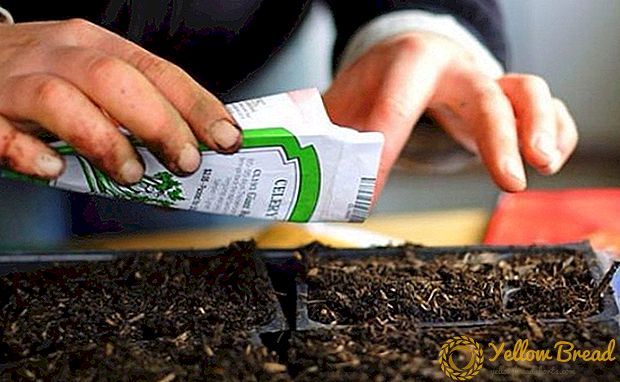 This may be an unheated balcony or a cold barn. Freezing the soil will help destroy the small insects in it that may threaten the normal cultivation of seedlings.
This may be an unheated balcony or a cold barn. Freezing the soil will help destroy the small insects in it that may threaten the normal cultivation of seedlings.
Sowing seeds
Before sowing seeds, you need to check with the lunar calendar and choose the most suitable day for sowing this crop. 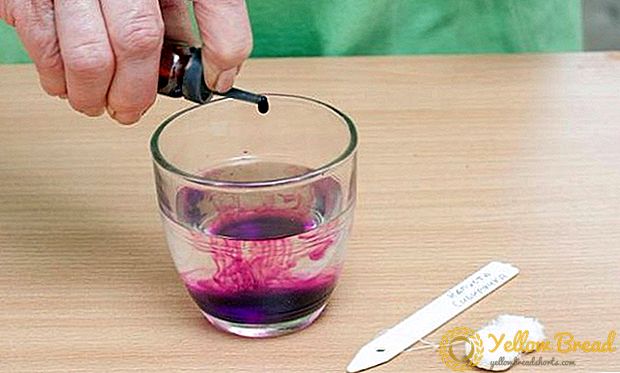 Preliminary preparation of seeds before sowing: Seeds are soaked in a pale pink solution of manganese for 25 minutes, then washed under running water. Then they are soaked overnight in any growth stimulator (Ivin, Epin) or aloe juice, honey and water solution (200 grams of warm water are for one tablespoon of honey).
Preliminary preparation of seeds before sowing: Seeds are soaked in a pale pink solution of manganese for 25 minutes, then washed under running water. Then they are soaked overnight in any growth stimulator (Ivin, Epin) or aloe juice, honey and water solution (200 grams of warm water are for one tablespoon of honey).
In the morning, the seeds are drained through a sieve of stimulating fluid, spread out evenly on newsprint and dried to flowability. Seeds are ready for sowing. 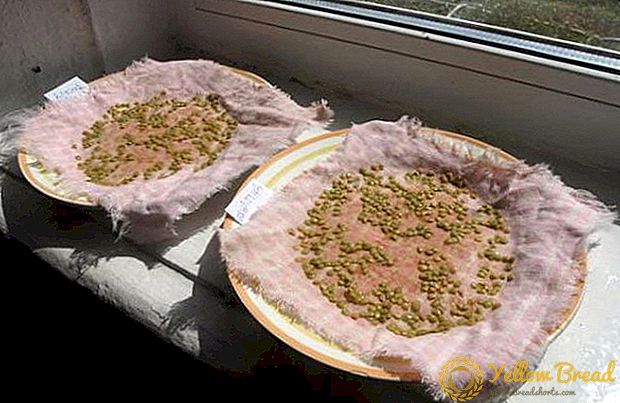 Boxes of soil are entered into a warm room the day before planting. During this time, the soil thawed and warmed up.
Boxes of soil are entered into a warm room the day before planting. During this time, the soil thawed and warmed up.
How to sow tomato seeds:
- the ground in the boxes must be leveled;
- mark up and perform marking of grooves for sowing on the ground (the distance between the furrows is 5 cm, the depth of the furrow is 1 cm);
- lightly pour the furrows and spread the seeds in them at a distance of 1 cm from each other;
- sprinkle the seeds with soil and once again moderately water (in no case do not pour!);
- put glass on top of the box or wrap the box in polyethylene (this will not allow the soil to dry out);
- put the box in a warm place (at the battery or heating boiler).
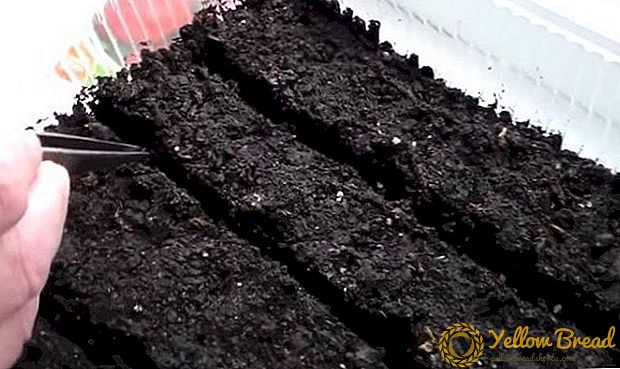
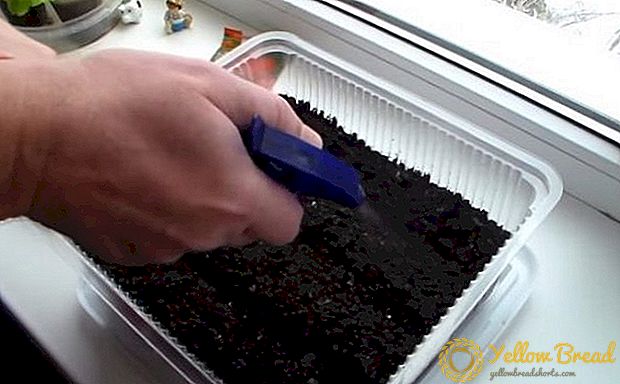
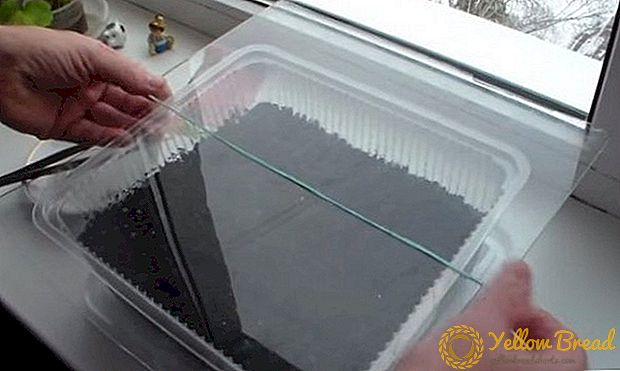
After 5-7 days, the first tender loops of tomato seedlings will appear on the ground surface. The box must be immediately relocated to a well-lit place (window-sill or a special illuminated seedling table).
Seedling care
Care for young seedlings is to moisten the spacing as the soil dries. Weekly, it is advisable to loosen the land between the rows in order to provide oxygen access to the roots of young seedlings. To loosen the ground in the razadnyh boxes conveniently with the help of a usual table fork.
Picking seedlings 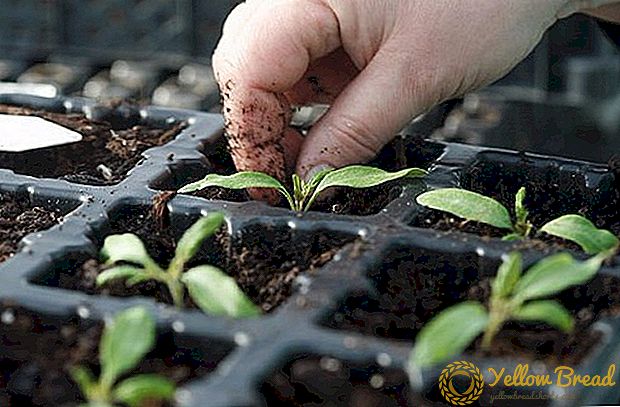 In two weeks, the first two true leaves will appear on young tomatoes - this is a signal to the planting of the plants.
In two weeks, the first two true leaves will appear on young tomatoes - this is a signal to the planting of the plants.
You can dive seedlings:
- in a bigger box;
- in the greenhouse, located on the street.
- the distance between rows of tomatoes should not be less than 7-8 cm;
- distance in the row between plants no more than 2-3 cm.
- distance in the row: 15-25 cm;
- the distance from tomato to tomato is 5-10 cm.
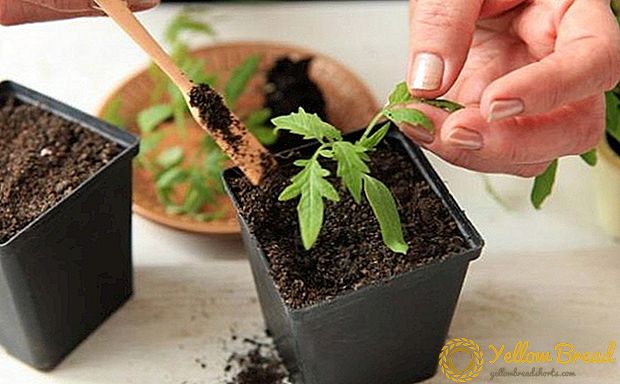
Seedlings and planting in the ground
After 40-45 days after the appearance of the first sprouts and the earth, the adult seedlings are ready for planting on a permanent place. The soil in which young plants will be planted should be pre-fertilized. 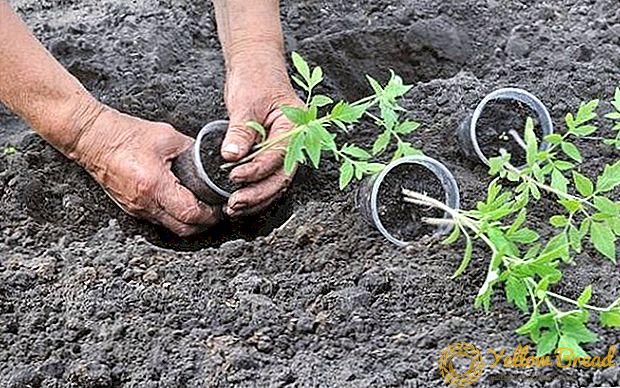 What fertilizer is suitable for tomato beds:
What fertilizer is suitable for tomato beds:
- humus;
- bog peat;
- compost;
- last year's cattle dung.
Arrangement of large-fruited tomatoes with a high bush on street beds:
- plants are arranged in two rows;
- distance between adults and tomatoes - 50 cm;
- the distance between the first and second row is 40 cm;
- tomatoes of the first row are staggered with respect to the tomatoes of the second row;
- after each two-row bed an intermediate track is made (80-100 cm).
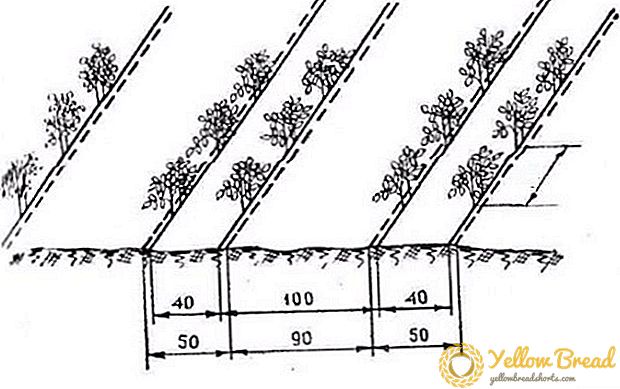 The layout of large-fruited tomatoes with a high stem in the greenhouse:
The layout of large-fruited tomatoes with a high stem in the greenhouse:- distance between plants - 25-30 cm;
- The second row of tomatoes is located relative to the first row in a checkerboard pattern;
- tracks in the greenhouse are stationary and do not depend on the cultivated crop;
- the garter of plants in the greenhouse is carried out only on vertical rope supports.
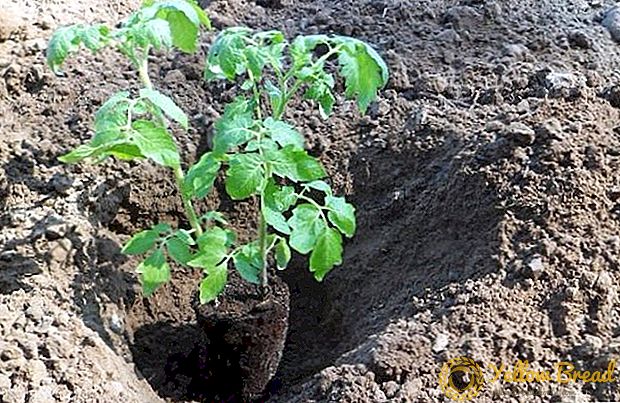
Care and watering
Tomato variety "Golden domes" is very responsive to irrigation. Especially important is watering plants that are in the flowering stage and fruit set. Not receiving the proper amount of moisture, the pollen on the flowers remains sterile and peels off without forming the ovary, and already established fruits cannot gain a large mass.
It is recommended to water the tomatoes only at the root (not on the leaf). This method of irrigation is preferable, since the culture is very unstable to fungal diseases. 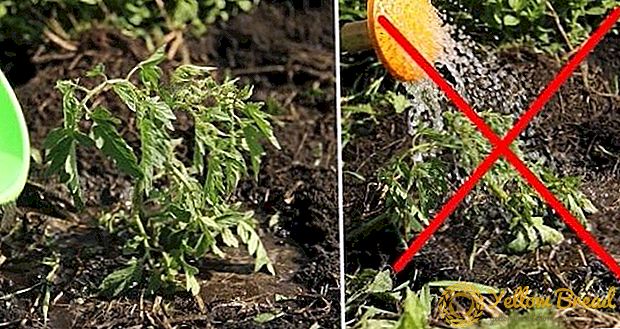 Tomatoes in open ground watered 2 times a week, in the evening, at the rate of 2-3 liters of water for each plant. In the greenhouse, tomatoes are watered every other day at the rate of: 1-1.5 liters of water per plant.
Tomatoes in open ground watered 2 times a week, in the evening, at the rate of 2-3 liters of water for each plant. In the greenhouse, tomatoes are watered every other day at the rate of: 1-1.5 liters of water per plant.
You can water the plants in several ways:
- to equip the beds or in the greenhouse drip irrigation;
- make grooves (aryk) along a number of plants. They are located in the root zone of the bush;
- a plastic bottle is dug in between two plants without a bottom. Water is poured into this bottle and the liquid gradually penetrates to the roots of plants.
- rope support;
- stationary or portable lanes (wooden or metal);
- wooden pegs.
Tomato is a perennial plant that is capable of perennial fruiting in the tropics, and only our cold winters prevent it. In our country, tomatoes are grown as a crop with a short life cycle (one summer). Such a technique as tomato shaping serves to receive as much fruit as possible from each plant during a warm period. 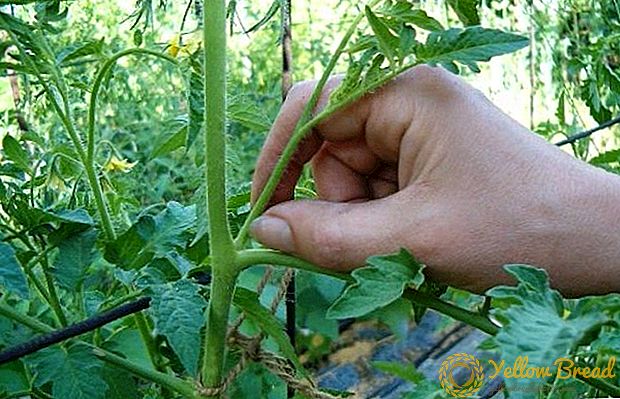 The formation of tomatoes implies their pasynkovanie. Gutting is the removal of the additional stalks that form, which appear in the sinuses between the main stem and the leaf of the tomato. Such stems are called stepsons and should be removed (up to 50 stepsons per plant per season). If the stepchildren are not removed, the plant suffers from an excess of branches, the fruit becomes shallow.
The formation of tomatoes implies their pasynkovanie. Gutting is the removal of the additional stalks that form, which appear in the sinuses between the main stem and the leaf of the tomato. Such stems are called stepsons and should be removed (up to 50 stepsons per plant per season). If the stepchildren are not removed, the plant suffers from an excess of branches, the fruit becomes shallow.
Formation of adult tomatoes "Golden domes" is carried out 3-4 fruit stalks, and the same variety, but grown in the greenhouse, is formed into one fruit stalk. Greenhouse shaping adapted for thick planting and garter plants for vertical rope supports. 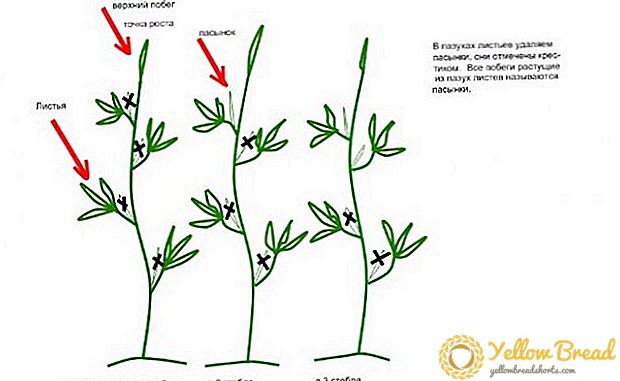 For street tomatoes in the northern regions of the country, the formation of two fruit stalks is recommended, for the southern regions, the formation of 3-4 stalks is recommended.
For street tomatoes in the northern regions of the country, the formation of two fruit stalks is recommended, for the southern regions, the formation of 3-4 stalks is recommended.
Pests and diseases
Tomatoes are subject to such diseases as:
- late blight;
- strick;
- verticillary wilting;
- cracking fruit;
- peak rot;
- cladosporia (brown spot);
- fomoz (brown rot of fruits);
- fusarium wilt;
- Alternaria (dry spotting);
- bacterial blotch;
- black leg (a disease of tomato seedlings).
- whitefly and slugs;
- spider mite and Colorado potato beetle;
- bear and wire;
- gnawing scoops.
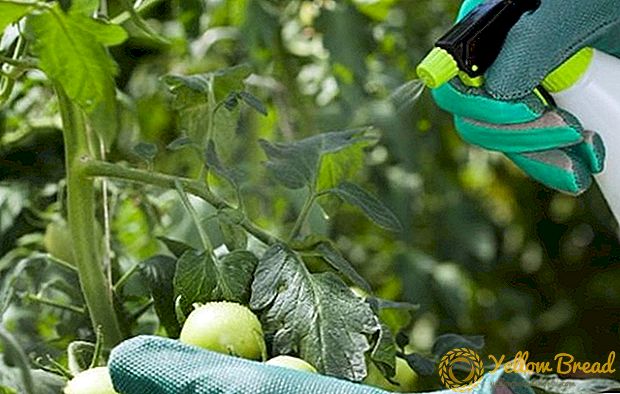 They include:
They include:- weeding between rows in beds and plant garters;
- avoiding excessive thickening when planting tomatoes;
- mulching the root layer and thinning the leaf cover;
- watering at the root;
- nipping the top of the plant (growth point) in the first decade of August.
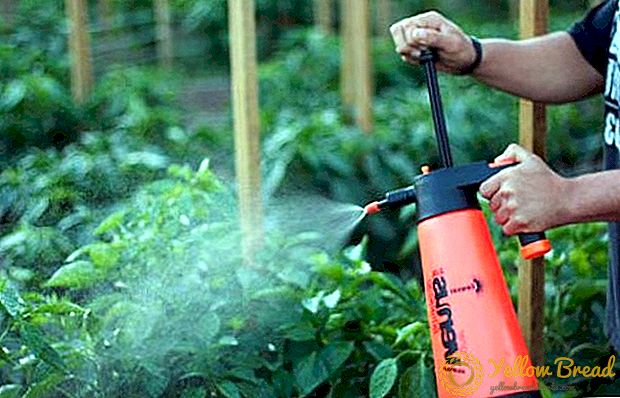
Conditions for maximum fruiting
Tomatoes "Golden domes" can help unleash the potential of the variety with the help of special preparations. For this, the plants are treated during the flowering period and during the pouring of the fruit by various stimulating substances.
Processing boric or succinic acid allows you to increase the number of ovaries in each brush. Growth stimulants (Epin, Heteroauxin, Biostim, Zircon, Rorish) will help the plant to quickly gain leaf and root mass, which will have a positive effect on the quantity and quality of the fruits obtained in the future.
Use of fruits
These tomatoes are great for slicing fresh, summer salads and for processing into juices. The juice from the “Golden domes” is thick, yellow-orange, fragrant, with a pronounced tomato flavor. 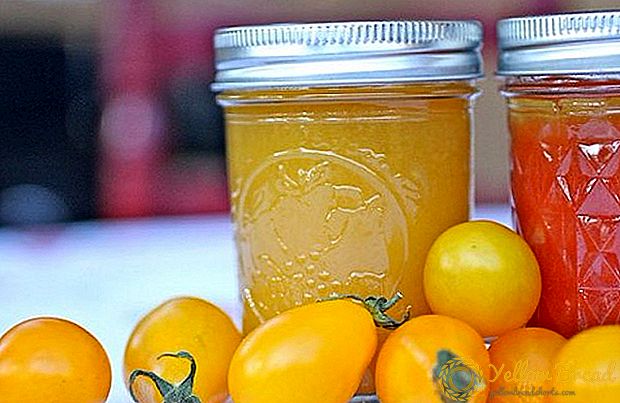 Tomato pulp is minced in a meat grinder or in a blender, and based on it, ketchup and adjika have an unusual yellow color. Winter blanks will delight the owners not only with taste, but also with sunny unusual appearance.
Tomato pulp is minced in a meat grinder or in a blender, and based on it, ketchup and adjika have an unusual yellow color. Winter blanks will delight the owners not only with taste, but also with sunny unusual appearance.
In the cultivation of tomatoes, the totality of all agronomic techniques is important, but even the most careful and conscientious care will not give good results if the tasteless or lean crop was originally chosen for planting. Tomatoes "Golden domes" were loved by summer residents and gardeners due to their remarkable taste, annual yield and unpretentiousness to the growing conditions.

